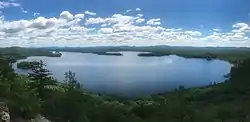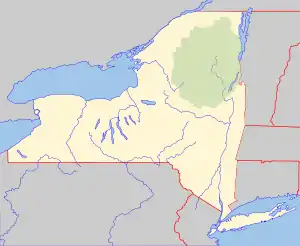Lake Lila
Lake Lila is a remote 1,436 acres (5.81 km2) lake in the William C. Whitney Wilderness Area, in the west-central portion of the Adirondack Park. It is accessed via a 6-mile (9.7 km) dirt road. Boat access to the lake is by hand-launch only, after a 0.3-mile (0.48 km) portage from the parking lot.
| Lake Lila | |
|---|---|
 Lake Lila, from Mount Frederica | |
 Lake Lila Location within New York  Lake Lila Lake Lila (the United States) | |
| Location | Adirondacks, Hamilton County, New York, United States |
| Coordinates | 44°00′10″N 74°45′15″W[1] |
| Type | Lake |
| Primary inflows | Shingle Shanty Brook |
| Primary outflows | Beaver River |
| Basin countries | United States |
| Max. length | 2.6 mi (4.2 km) |
| Max. width | 2 mi (3.2 km) |
| Surface area | 1,436-acre (5.81 km2)[1] |
| Average depth | 15 feet (4.6 m) |
| Max. depth | 64 feet (20 m) |
| Shore length1 | 8.8 miles (14.2 km) |
| Surface elevation | 1,716 ft (523 m)[1] |
| Islands | 6 |
| 1 Shore length is not a well-defined measure. | |
It is the twenty-second largest body of water in the park, and the largest lake in the Adirondack Park whose shoreline is entirely state-owned. Of the 100 largest lakes in the park, it is one of only five which are free of motorboats, jetskis, and floatplanes, including Lows, Little Tupper, Round, and Saint Regis Pond.[2]
The southeastern portion of Lake Lila is an extensive wetland drained by the Shingle Shanty Brook, which feeds the lake; the lake is drained by the Beaver River. The lake is bordered by 2,220-foot (680 m) Mount Frederica.
There are 24 primitive campsites, 18 of which are accessible only by boat.
Fish found within Lake Lila include smallmouth bass, lake trout, yellow perch, and brown bullhead. Landlocked salmon and brook trout are present in very small numbers.[3]
History
Lake Lila was originally called Smith Lake. William Seward Webb assembled a 115,000-acre (470 km2) preserve, called Nehasane Park,[4] in the process of creating the Mohawk and Malone Railway. Webb built a Great Camp, Forest Lodge, on the western shore of Smith Lake, which he renamed for his wife Lila (Eliza Osgood Vanderbilt Webb).
In 1979, New York State acquired the 7,200 acres (29 km2) of Nehasane Park surrounding Lake Lila; Forest Lodge was razed by the state at the request of the Webb family as part of the acquisition process. The railway station that formerly served the lodge still stands. The area was originally known as Lake Lila Primitive Area, before it was made a part of the William C. Whitney Wilderness Area in 1997. The railroad right-of-way is now the Remsen-Lake Placid Travel Corridor.
References
- "Lake Lila". Geographic Names Information System. United States Geological Survey. Retrieved May 30, 2020.
- "'Myth' of quiet Adirondacks challenged by environmental group". North Country Now. Retrieved 12 July 2018.
- "Lake Lila". Department of Environmental Conservation. New York State. Retrieved 12 July 2018.
- "De William Seward Webb's Great Park" (PDF). The Albany Journal. 31 January 1895. Retrieved 12 July 2018.